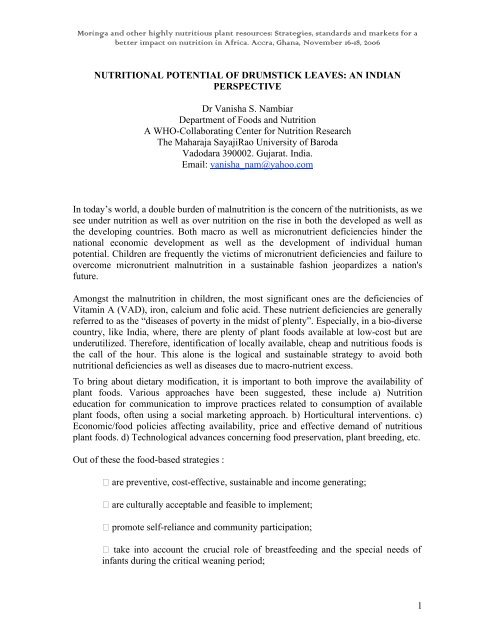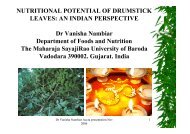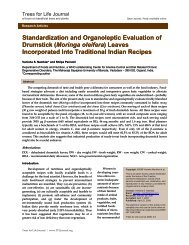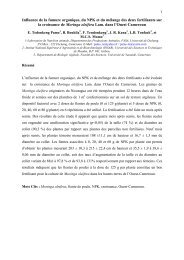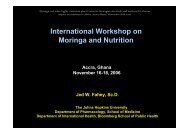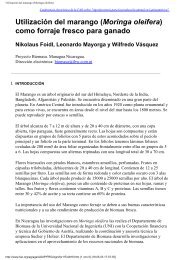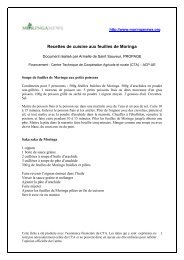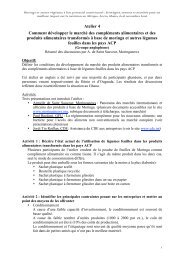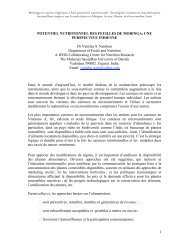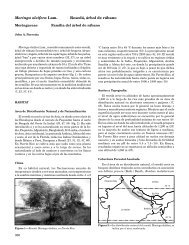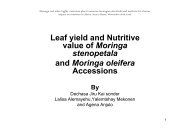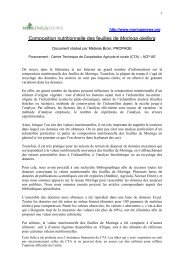Nutritional potential of drumstick leaves : an Indian ... - Moringanews
Nutritional potential of drumstick leaves : an Indian ... - Moringanews
Nutritional potential of drumstick leaves : an Indian ... - Moringanews
You also want an ePaper? Increase the reach of your titles
YUMPU automatically turns print PDFs into web optimized ePapers that Google loves.
Moringa <strong>an</strong>d other highly nutritious pl<strong>an</strong>t resources: Strategies, st<strong>an</strong>dards <strong>an</strong>d markets for abetter impact on nutrition in Africa. Accra, Gh<strong>an</strong>a, November 16-18, 2006NUTRITIONAL POTENTIAL OF DRUMSTICK LEAVES: AN INDIANPERSPECTIVEDr V<strong>an</strong>isha S. NambiarDepartment <strong>of</strong> Foods <strong>an</strong>d NutritionA WHO-Collaborating Center for Nutrition ResearchThe Maharaja SayajiRao University <strong>of</strong> BarodaVadodara 390002. Gujarat. India.Email: v<strong>an</strong>isha_nam@yahoo.comIn today’s world, a double burden <strong>of</strong> malnutrition is the concern <strong>of</strong> the nutritionists, as wesee under nutrition as well as over nutrition on the rise in both the developed as well asthe developing countries. Both macro as well as micronutrient deficiencies hinder thenational economic development as well as the development <strong>of</strong> individual hum<strong>an</strong><strong>potential</strong>. Children are frequently the victims <strong>of</strong> micronutrient deficiencies <strong>an</strong>d failure toovercome micronutrient malnutrition in a sustainable fashion jeopardizes a nation'sfuture.Amongst the malnutrition in children, the most signific<strong>an</strong>t ones are the deficiencies <strong>of</strong>Vitamin A (VAD), iron, calcium <strong>an</strong>d folic acid. These nutrient deficiencies are generallyreferred to as the “diseases <strong>of</strong> poverty in the midst <strong>of</strong> plenty”. Especially, in a bio-diversecountry, like India, where, there are plenty <strong>of</strong> pl<strong>an</strong>t foods available at low-cost but areunderutilized. Therefore, identification <strong>of</strong> locally available, cheap <strong>an</strong>d nutritious foods isthe call <strong>of</strong> the hour. This alone is the logical <strong>an</strong>d sustainable strategy to avoid bothnutritional deficiencies as well as diseases due to macro-nutrient excess.To bring about dietary modification, it is import<strong>an</strong>t to both improve the availability <strong>of</strong>pl<strong>an</strong>t foods. Various approaches have been suggested, these include a) Nutritioneducation for communication to improve practices related to consumption <strong>of</strong> availablepl<strong>an</strong>t foods, <strong>of</strong>ten using a social marketing approach. b) Horticultural interventions. c)Economic/food policies affecting availability, price <strong>an</strong>d effective dem<strong>an</strong>d <strong>of</strong> nutritiouspl<strong>an</strong>t foods. d) Technological adv<strong>an</strong>ces concerning food preservation, pl<strong>an</strong>t breeding, etc.Out <strong>of</strong> these the food-based strategies :are preventive, cost-effective, sustainable <strong>an</strong>d income generating;are culturally acceptable <strong>an</strong>d feasible to implement;promote self-reli<strong>an</strong>ce <strong>an</strong>d community participation;take into account the crucial role <strong>of</strong> breastfeeding <strong>an</strong>d the special needs <strong>of</strong>inf<strong>an</strong>ts during the critical we<strong>an</strong>ing period;1
Moringa <strong>an</strong>d other highly nutritious pl<strong>an</strong>t resources: Strategies, st<strong>an</strong>dards <strong>an</strong>d markets for abetter impact on nutrition in Africa. Accra, Gh<strong>an</strong>a, November 16-18, 2006Nutritionists are now trying to encourage cultivation <strong>an</strong>d incorporation <strong>of</strong> GLVs invarious recipes with minimum effort <strong>an</strong>d little cost, yielding a great benefit. Devisingseveral simple <strong>an</strong>d acceptable carotene rich recipes containing GLVs would not onlybring variety to the diet <strong>an</strong>d but also help in combating vitamin A deficiency along withother micronutrient deficiencies.Several gaps <strong>of</strong> knowledge with respect to the stability <strong>of</strong> -carotene from foods <strong>an</strong>dtherefore its bioavailability exist. Studies on the retention <strong>of</strong> total <strong>an</strong>d beta carotene <strong>of</strong><strong>drumstick</strong> <strong>leaves</strong> on pressure cooking with selected bioactive compounds namely oil (5g),ascorbic acid (25 mg), tomatoes (10g) <strong>an</strong>d polyphenols (~1.5g); indicated that the oil hada maximum positive impact (76-99% retention <strong>of</strong> BC).It is generally considered that there is sufficient documentation to conclude that foodbased approaches using provitamin A sources, when adequately implemented, areeffective in the control <strong>of</strong> vitamin A deficiency, <strong>an</strong>d contribute to alleviating the otherusual accomp<strong>an</strong>ying nutritional deficits. Other studies have shown that beta carotenefrom foods may have only limited availability as compared to isolated beta carotene in<strong>an</strong>imal models. Bioavailability trials using fresh as well as bl<strong>an</strong>ched <strong>an</strong>d sulphited shadedehydrated <strong>drumstick</strong> <strong>leaves</strong> were conducted on vitamin A deficient rats. Male Charlesfoster strain <strong>of</strong> rats were fed on a synthetic vitamin A deficient diet for 4 weeks <strong>an</strong>dthereafter repleted with 4000 IU vitamin A/kg diet from either fresh or dehydrated<strong>drumstick</strong> <strong>leaves</strong> or synthetic vitamin A acetate for the following 4 weeks. These werecompared with a control group <strong>of</strong> rats fed on a basal diet adequate in vitamin A for 8weeks. The diets were iso-caloric <strong>an</strong>d iso-nitrogenous. The parameters tested were: bodyweights, food intake, clinical signs <strong>an</strong>d symptom, org<strong>an</strong> weights, serum <strong>an</strong>d liver retinollevels. The results revealed that the dehydrated <strong>drumstick</strong> <strong>leaves</strong> produced a markedincrease in food intake, weight gain <strong>an</strong>d liver vitamin A, compared to fresh <strong>drumstick</strong><strong>leaves</strong> or synthetic vitamin A. In the developing countries like India, sources <strong>of</strong> vitaminA such as <strong>drumstick</strong> <strong>leaves</strong> are valuable in overcoming the problem <strong>of</strong> vitamin Adeficiency. These findings also accentuate the import<strong>an</strong>ce <strong>of</strong> carotene on the vitamin Astatus, <strong>an</strong>d underscore its equivalence to synthetic vitamin A when fed in the rightamount (Nambiar <strong>an</strong>d Seshadri 2001).Diet surveys in India clearly indicate that diets, particularly <strong>of</strong> the preschool childrensuffer from several deficiencies <strong>of</strong> which vitamin A is <strong>an</strong> import<strong>an</strong>t one. Studies on diets<strong>of</strong> young children indicate that the caregivers make no specific attempts to include GLVsin the diets <strong>of</strong> their children. There are very few studies that have looked into theacceptability <strong>of</strong> recipes modified with different GLVs <strong>an</strong>d assessed their impact on veryyoung children, although there is no dearth <strong>of</strong> recipes per say.Supplementary Feeding Program (SFP) <strong>of</strong> the Integrated Child Develpoment Scheme <strong>of</strong>India, aims at the improvement in the nutritional status <strong>of</strong> the preschool children <strong>an</strong>d is <strong>an</strong>ideal platform to introduce DDL into the diets <strong>of</strong> this target group as a nutritionalintervention. This program reaches the doorsteps <strong>of</strong> the underprivileged communitygroups by the virtue <strong>of</strong> several service oriented Non Governmental Org<strong>an</strong>isations(NGOs) who are chiefly involved in the preparation <strong>of</strong> the supplementary food. An3
Moringa <strong>an</strong>d other highly nutritious pl<strong>an</strong>t resources: Strategies, st<strong>an</strong>dards <strong>an</strong>d markets for abetter impact on nutrition in Africa. Accra, Gh<strong>an</strong>a, November 16-18, 20066. V<strong>an</strong>isha Nambiar (2002). Use <strong>of</strong> posters developed for the Sight <strong>an</strong>d Lifedrawing competition for increasing the awareness on vitamin A in children. Sight<strong>an</strong>d Life Newsletter 2/2002: 21-23.7. V<strong>an</strong>isha S. Nambiar <strong>an</strong>d Subadra Seshadri (2001). Bioavailability <strong>of</strong> betacarotene from fresh <strong>an</strong>d dehydrated <strong>drumstick</strong> leave s in a rat model. Journal <strong>of</strong>Pl<strong>an</strong>t Foods for Hum<strong>an</strong> Nutrition, Vol. 56, No. 1, 2001, pp 83-95.8. V<strong>an</strong>isha S. Nambiar <strong>an</strong>d Subadra Seshadri (2001). Retention <strong>of</strong> total <strong>an</strong>d betacarotene from fresh radish <strong>leaves</strong> in steamed, sautéed <strong>an</strong>d baked products <strong>of</strong>Western India. Journal <strong>of</strong> Food <strong>an</strong>d Science <strong>an</strong>d Technology. Vol 38 (5): 458-461.9. V<strong>an</strong>isha S. Nambiar <strong>an</strong>d Subadra Seshadri (1998). Beta carotene content <strong>of</strong> greenleafy vegetables <strong>of</strong> Western India by HPLC. Journal <strong>of</strong> Food Science <strong>an</strong>dTechnology. 35 (4): 365-367.10. V<strong>an</strong>isha Nambiar, Kavita Sharma <strong>an</strong>d Hem<strong>an</strong>gini G<strong>an</strong>dhi (2005). Food BasedApproach to Combat Vitamin A Deficiency. UGC-DSA Monograph Series No. 3.Department <strong>of</strong> Foods <strong>an</strong>d Nutrition, M.S.University <strong>of</strong> Baroda, Vadodara 390002.11. Subadra Seshadri <strong>an</strong>d V<strong>an</strong>isha S Nambiar (2003). K<strong>an</strong>jero (Digera arvensis) <strong>an</strong>dDrumstick <strong>leaves</strong> (Moringa oleifera): Nutrient pr<strong>of</strong>ile <strong>an</strong>d <strong>potential</strong> for Hum<strong>an</strong>consumption. In: pl<strong>an</strong>ts in Hum<strong>an</strong> Health <strong>an</strong>d Nutrition policy. World Review <strong>of</strong>Nutrition <strong>an</strong>d Dietetics. Basel, Karger. Vol 91: 41-56.12. V<strong>an</strong>isha S Nambiar <strong>an</strong>d Purvi Kosambia (2002). Assessing the community risk <strong>of</strong>vitamin A deficiency: impact <strong>of</strong> nutrition education programs in improvingvitamin A behavior. A report submitted to the Primary School Board, Urb<strong>an</strong>Vadodara.13. V<strong>an</strong>isha S. Nambiar <strong>an</strong>d Purvi Kosambia (2004). Nutrition guid<strong>an</strong>ce to schoolchildren (7-13y) consuming negligible amounts <strong>of</strong> vitamin A foods using a tripleapproach. Abstract: In the proceedings <strong>of</strong> XXII International Vitamin AConsultative Group meeting, Vitamin A <strong>an</strong>d the Common Agenda forMicronutrients. Lima, Peru. Nov 15-17.14. V<strong>an</strong>isha S Nambiar <strong>an</strong>d Subadra Seshadri (2001). Stability <strong>of</strong> beta carotene frompl<strong>an</strong>t foods in the presence <strong>of</strong> other biologically active compounds. Abstract: InThe Proceedings <strong>of</strong> “Bioavailability 2001”, Interlaken, Switzerl<strong>an</strong>d. May 30-June1.5
Moringa <strong>an</strong>d other highly nutritious pl<strong>an</strong>t resources: Strategies, st<strong>an</strong>dards <strong>an</strong>d markets for abetter impact on nutrition in Africa. Accra, Gh<strong>an</strong>a, November 16-18, 200615. Revathy R, V<strong>an</strong>isha S Nambiar <strong>an</strong>d Subadra Seshadri (2001). Impact <strong>of</strong>Dehydrated Drumstick Leaf Biscuits on Vitamin A Status <strong>of</strong> Children as Assessedby Conjunctival Impression Cytology. Abstract: In The Proceedings <strong>of</strong> XXInternational Vitamin A Consultative Group, H<strong>an</strong>oi, Vietnam, Feb 12-15.16. Rina T<strong>an</strong>na, V<strong>an</strong>isha S Nambiar <strong>an</strong>d Subadra Seshadri (2001). Retention <strong>of</strong>Selected Minerals <strong>an</strong>d Antinutrients in Some Common GLVs <strong>of</strong> rural <strong>an</strong>d tribalGujarat subjected to pretreatments, dehydration <strong>an</strong>d storage. Abstract: In TheProceedings <strong>of</strong> XX INACG symposium, H<strong>an</strong>oi, Vietnam. Feb 15-16.17. V<strong>an</strong>isha S Nambiar <strong>an</strong>d Subadra Seshadri (2001). Green Leafy Vegetables <strong>of</strong>India - Immense Potential as a Source <strong>of</strong> Food, Nutrition <strong>an</strong>d Medicine. Abstract:In The Proceedings <strong>of</strong> the Indi<strong>an</strong> Science Congress Association, 88 th ScienceCongress. Committee on Home Science, New Delhi. J<strong>an</strong> 3-8.18. V<strong>an</strong>isha S Nambiar <strong>an</strong>d Subadra Seshadri (2000). Assessing the feasibility <strong>an</strong>dimpact <strong>of</strong> feeding micronutrient rich <strong>drumstick</strong> <strong>leaves</strong> to young children throughthe supplementary feeding programme <strong>of</strong> the ICDS. Abstract: In The Proceedings<strong>of</strong> the National Symposium on Child health <strong>an</strong>d Nutrition. Department <strong>of</strong> Foods<strong>an</strong>d Nutrition. M.S.University <strong>of</strong> Baroda. Dec 21-23.19. V<strong>an</strong>isha Patel <strong>an</strong>d Subadra Seshadri (1994). Analysis <strong>of</strong> six green leafyvegetables using two different HPLC systems , their nutrient pr<strong>of</strong>ile <strong>an</strong>dimplications. Abstract: In The Proceedings <strong>of</strong> the Nutrition Society <strong>of</strong> India,XXVI <strong>an</strong>nual conference, Hyderabad. November 24-25.This paper Received the Junior Scientist Award in “Experimental Nutrition”20. Purvi Kosambia <strong>an</strong>d V<strong>an</strong>isha Nambiar (2002). Poster on Food Sources <strong>of</strong> VitaminA. Department <strong>of</strong> Foods <strong>an</strong>d Nutrition, M.S.University <strong>of</strong> Baroda, Vadodara390002. (Used For Children 7-13 y old, Primary Schools Vadodara, VUDA.21. V<strong>an</strong>isha Nambiar (2001) Four Poster <strong>of</strong> vitamin A deficiency. ‘Sight <strong>an</strong>d Life”- ahum<strong>an</strong>itari<strong>an</strong> initiative <strong>of</strong> the H<strong>of</strong>fm<strong>an</strong>n la Roche, Basel Switzerl<strong>an</strong>d.One <strong>of</strong> which was awarded the 1 st prize in the international poster competition,which was received in Switzerl<strong>an</strong>d. The other three were in the best 25.22. V<strong>an</strong>isha Nambiar (2000). Fact Sheets on Vitamin A deficiency. Department <strong>of</strong>Foods <strong>an</strong>d Nutrition, M.S.University <strong>of</strong> Baroda, Vadodara 390002.6
Moringa <strong>an</strong>d other highly nutritious pl<strong>an</strong>t resources: Strategies, st<strong>an</strong>dards <strong>an</strong>d markets for abetter impact on nutrition in Africa. Accra, Gh<strong>an</strong>a, November 16-18, 200623. Subadra Seshadri, V<strong>an</strong>isha Patel, Hem<strong>an</strong>gini G<strong>an</strong>dhi <strong>an</strong>d Devakin<strong>an</strong>d<strong>an</strong>Dhabhai: (1994). A Calendar on the cost <strong>an</strong>d seasonal availability <strong>of</strong> betacarotenerich foods available in Gujarat. Department <strong>of</strong> Foods <strong>an</strong>d Nutrition,M.S.University <strong>of</strong> Baroda, Vadodara 390002 <strong>an</strong>d Nutrition Foundation <strong>of</strong> India,New Delhi.7


